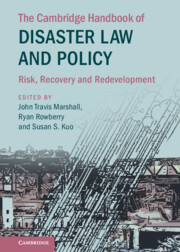Book contents
- The Cambridge Handbook of Disaster Law and Policy
- The Cambridge Handbook of Disaster Law and Policy
- Copyright page
- Dedication
- Contents
- Figures
- Maps
- Tables
- Contributors
- Foreword: Current Trends in Disaster Law and Policy
- Acknowledgments
- Introduction
- Part I Critical Perspectives on the Evolution of Disaster Law and Policy
- Part II Effective Governance as an Imperative for Responsive Disaster Law and Policy
- Part III Law’s Role in Promoting Hazard Mitigation: Intergovernmental, International, National, and Local Approaches
- Part IV Private Sector Initiatives to Promote Disaster Resilience and Recovery
- Part V Lawyers As Disaster Law and Policy Leaders: Training for Students and Guidance for Practitioners
- Part VI Cultural Heritage Protection and Cross-Disciplinary Opportunities for Advancing Disaster Law and Policy
- Part VII Disasters and Vulnerable Communities
- 30 After the Storm: The Importance of Acknowledging Environmental Justice in Sustainable Development and Disaster Preparedness
- 31 Social Constructions of Disaster Survivors and Displaced Populations: Implications for Policy Design
- 32 From Covid-19 to Climate Change: Disaster and Inequality at the Crossroads
- 33 Disasters and Disability
32 - From Covid-19 to Climate Change: Disaster and Inequality at the Crossroads
from Part VII - Disasters and Vulnerable Communities
Published online by Cambridge University Press: 27 October 2022
- The Cambridge Handbook of Disaster Law and Policy
- The Cambridge Handbook of Disaster Law and Policy
- Copyright page
- Dedication
- Contents
- Figures
- Maps
- Tables
- Contributors
- Foreword: Current Trends in Disaster Law and Policy
- Acknowledgments
- Introduction
- Part I Critical Perspectives on the Evolution of Disaster Law and Policy
- Part II Effective Governance as an Imperative for Responsive Disaster Law and Policy
- Part III Law’s Role in Promoting Hazard Mitigation: Intergovernmental, International, National, and Local Approaches
- Part IV Private Sector Initiatives to Promote Disaster Resilience and Recovery
- Part V Lawyers As Disaster Law and Policy Leaders: Training for Students and Guidance for Practitioners
- Part VI Cultural Heritage Protection and Cross-Disciplinary Opportunities for Advancing Disaster Law and Policy
- Part VII Disasters and Vulnerable Communities
- 30 After the Storm: The Importance of Acknowledging Environmental Justice in Sustainable Development and Disaster Preparedness
- 31 Social Constructions of Disaster Survivors and Displaced Populations: Implications for Policy Design
- 32 From Covid-19 to Climate Change: Disaster and Inequality at the Crossroads
- 33 Disasters and Disability
Summary
As the pace of climate change accelerates, the impacts of a warming world become more evident and more inevitable. Climate change multiplies and compounds stresses on human and natural systems and amplifies the risk and implications of slow- and sudden-onset disasters worldwide. Some of these risks can be avoided. Some can be alleviated. Some, however, may now or soon be unescapable. The risk continuum is shaped by the degree to which the international community mobilizes to mitigate emissions, to facilitate adaptation, and to prepare for climate-related impacts that cannot be eased or eliminated. The less we do to mitigate, adapt, and prepare, the more acute the risks of climate change become, especially in the global south and especially for already-vulnerable communities. With average global temperatures currently on track to exceed the 2°C target, climate change is expected to multiply the number of people susceptible to poverty, undermine food security, intensify heat and water stress, and increase the risks of fires, storms, flooding, landslides, and infectious and parasitic diseases. In this world of amplified risk, the lines between natural disasters and climate-related disasters blur. Even as these lines blur and the demand for improved coordination grows, critical institutional and legal disjunctions remain. Focusing on the Warsaw Mechanism for Loss & Damage, this chapter examines evolving efforts to construct a more effective and equitable rule of law and institutional framework at the intersection of climate change and disaster law.
Keywords
- Type
- Chapter
- Information
- The Cambridge Handbook of Disaster Law and PolicyRisk, Recovery, and Redevelopment, pp. 511 - 524Publisher: Cambridge University PressPrint publication year: 2022



